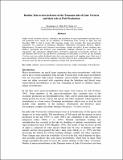| dc.description.abstract | Studies on the taxonomic diversity, abundance and distribution of macro-invertebrates and their role in
fish production were carried out on sediments of Southeastern Lake Victoria in April, July and
December 2000. A total of twenty (20) taxonomic groups were recorded. The macro-invertebrate
community was composed of Turbellaria, Hirudinae, Oligochaete, Gastropoda, Bivalvia, Diptera,
Ephemeroptera, Tricoptera and Coleoptera (larvae/pupae, nymphs and adults). In most sampling zones
molluscs (gastropods and bivalves) were numerically dominant followed by insect larvae and
oligochaetes. The oligochaetes (Haplotaxidae), Gastropoda comprising of Viviparidae (Bellamya sp)
and Thiaridae (Melanoides sp) and Bivalvia constituting of Corbiculidae (Corbicula sp) and Uionidae
(Caelatura sp) were widely distributed since they were represented in all sampling zones. Most taxa of
macro-invertebrates observed in the sediments were prey items for most commercially important fishes
observed in the lake and are therefore important in energy flow and fish production. | en_US |

